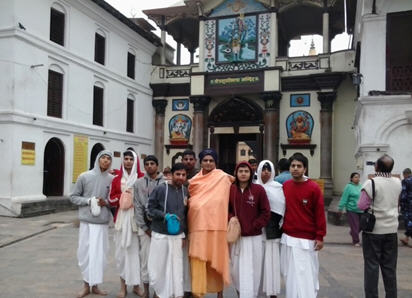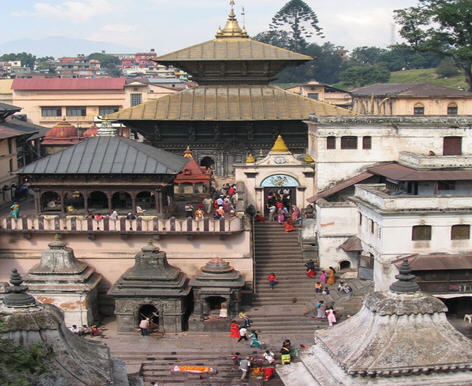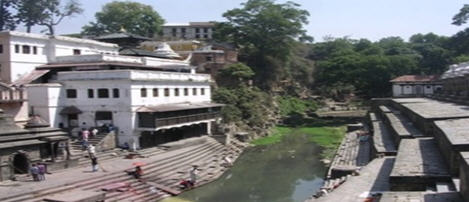Pashupatinath, or Pashupati, is the most famous and beautiful Shiva temple on the banks of the Bagmati River in Deopatan, a village 3 km northwest of Kathmandu. It is dedicated to a manifestation of Shiva called Pashupati (Lord of Animals). It attracts thousands of pilgrims each year and has become main place of attraction in Kathmandu.
. 
]
Pashupatinath temple stands in the center of the town of Deopatan, in the middle of an open courtyard. It is a square, two-tiered pagoda temple built on a single-tier plinth, and it stands 23.6 meters above the ground. Richly ornamented gilt and silver-plated doors are on all sides
.
The priests of Pashaputinath are called Bhattas and the chief priest is called Mool Bhatt or Raval. The chief priest is answerable only to the King of Nepal and reports to him on temple matters on a periodic basis.
Pashaputinath temple’s extensive grounds include many other old and important temples, shrines and deities. In the northeast corner of the temple courtyard is the small pagoda temple of Vasuki, the King of the Nagas. According to locals, Vasuki took up residence here in order to guard Pashupatinath temple and thus serve Lord Shiva. One can often see devotees circumambulating and worshipping Vasuki before entering the main sanctum
. 
The Bagmati river, which runs next to Pashupatinath temple, has highly sacred properties. Thus the banks are lined with many ghats (bathing spots) for use by pilgrims. Renovating or furnishing these sites has always been regarded as meritorious.
Arya Ghat, dating from the early 1900s, is of special importance because it is the only place where lustral water for worship of Pashupatinath is obtained and it is where members of the royal family are cremated. The main cremation site however ,is Bhasmeshvar Ghat, which is the most-used cremation site in the Kathmandu Valley. The preferred bathing spot for women is the Gauri Ghat, to the north.
The full tour of visiting Dwadash jyotirling (12 famous shivalinga) as well as 4 dham tour is considered full complete after visiting Pashupatinath. This deity of Lord Shiva is considered the face of Lord Shiva when he appeared in form of a bull. It is said when the Five Pandavas came to Himalayas, Bhima performed penance to Lord Shiva to purify himself from sins. Lord Shiva decided to not give darshan to Bhima and to do so he took a form of a Bull and ran away. Understanding it, Bhima chased this bull. Finally the bull in order to hide entered inside the earth. However in process of doing so, His hump remained visible which is today said to be Kedarnath Shivalinga. As Lord Shiva in the form of bull hid himself in the earth , the bull came out on the other side in the Himalayas with just his face out. This face portion came out here in Kathmandu and became known to be worshippable Pashupatinath. Hence the local say that Char dham is complete when they see the face of Lord as Bull here.